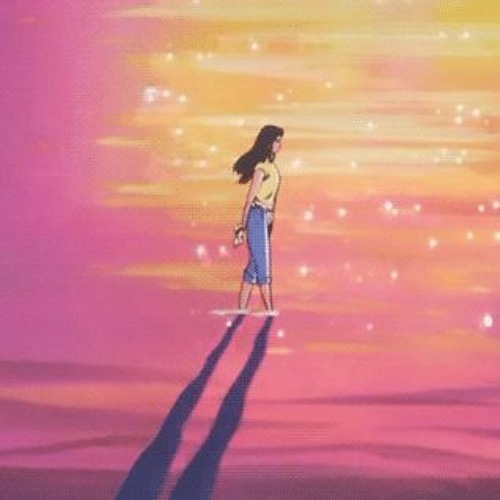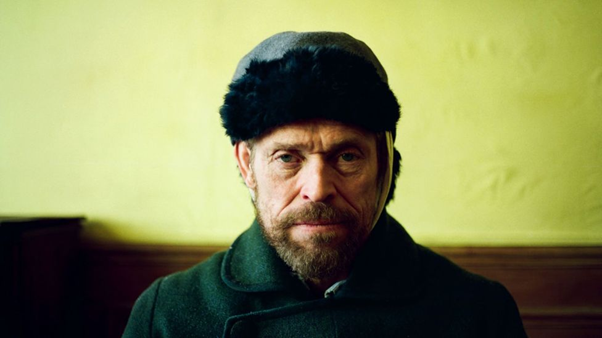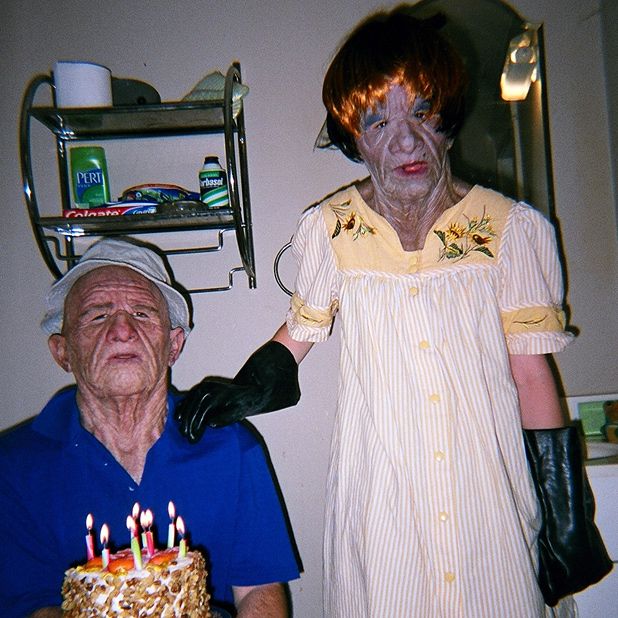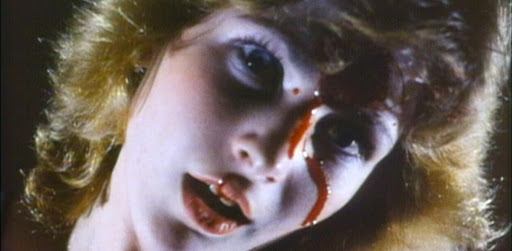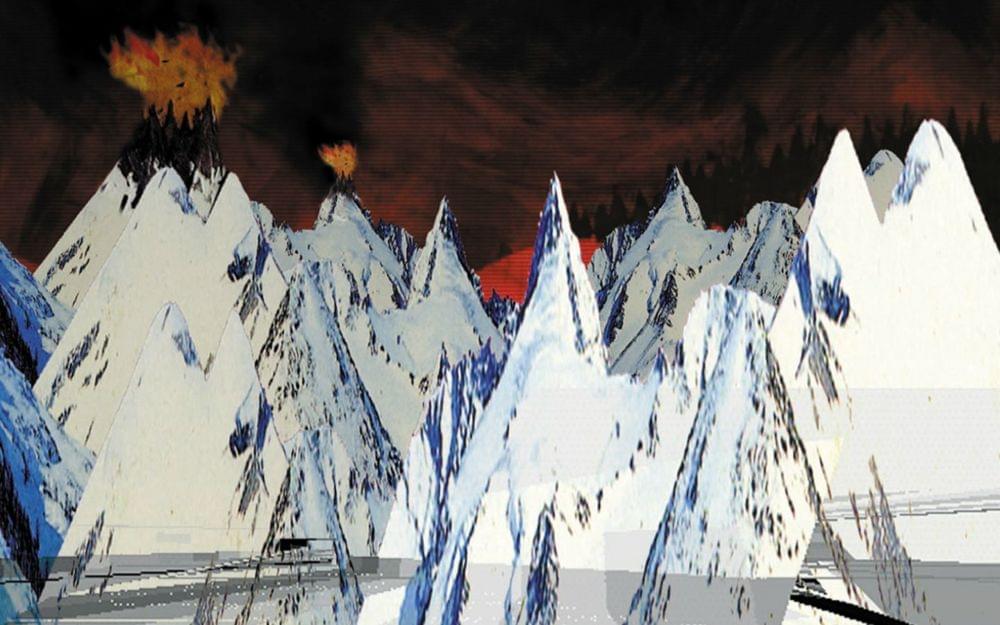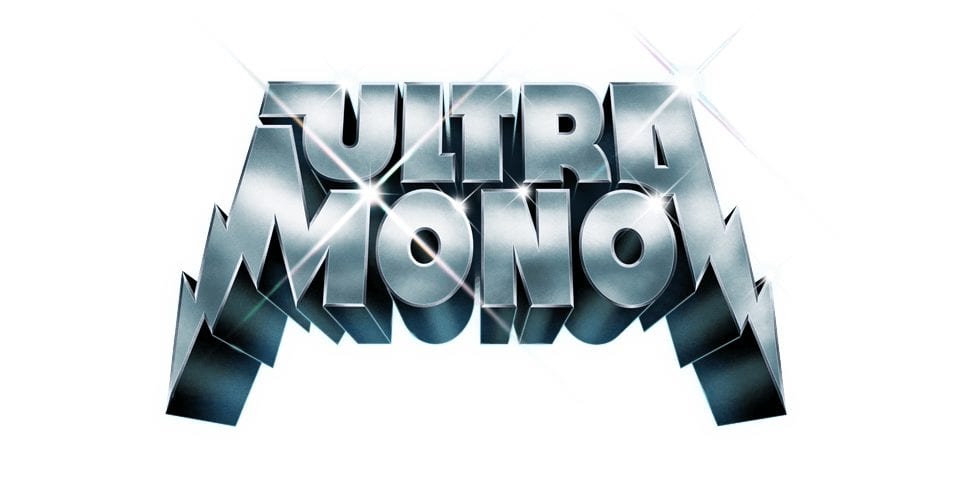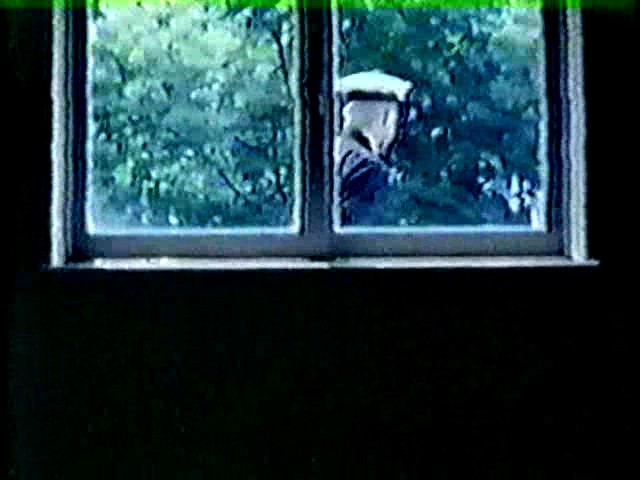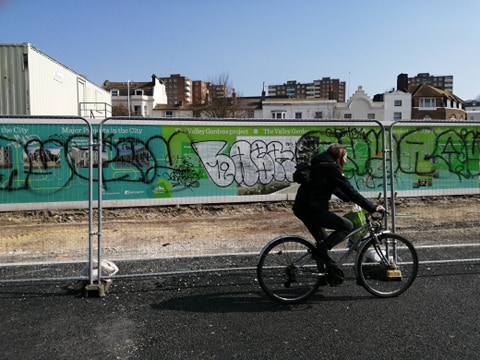To motivate myself into being a better writer, and also to be more well-rounded culturally, I have embarked on a project to watch every video in the Film section of the invaluable online treasure-trove UbuWeb. I will randomly select an artist, and watch every one of the videos pertaining to that artist; once I have done this, I will randomly select another artist and start anew. I will write up my thoughts on the videos pertaining to that artist, however disparate or incoherent, here. I hope that by declaring this so openly, it will create a culture of accountability to myself that will see me through the project. This is the first entry, and the artist is Harrell Fletcher.
Continue reading “The UbuWeb Project #1: Harrell Fletcher”Sliced n’ Spread: The Strange Allure of ‘Slowed and Reverb’ YouTube Videos
The internet’s capacity for collective unconscious lives and dies by its ability to generate self-referentiality. It’s the difference between ‘being online’ and being a ‘normie’; you’re either in on the joke, or you’re not. Being in on the joke requires nothing more than being in the right place at the right time, which usually comes about from being available in all places, all of the time. If you manage this, then you can catch the little whisps of information that curl from the top of the digital stock pot, accumulate on the roofs of our agape mouths, perforate our membrain, and generate little self-referential spores of mold that can be self-referenced back to ad infinitum.
Continue reading “Sliced n’ Spread: The Strange Allure of ‘Slowed and Reverb’ YouTube Videos”Subjective Gaze in At Eternity’s Gate
“God is nature, and nature is beauty.”
Julian Schnabel’s At Eternity’s Gate, a biopic of Vincent Van Gogh (Willem Defoe), is a lush and pastoral film, imbued with the same depth and tactility that characterised the artist’s paintings. It is full of ruminations on beauty and nature, such as the above quote, but it curiously seems to argue against those things as a salve or saviour; although they made Van Gogh’s life more tolerable, and deeply informed his art, they were ineffective in saving Van Gogh from his inner torpor. Ambiguously, and perhaps wisely, the film doesn’t seek to pathologise or categorise, with a modern lens, whatever it was that afflicted the great artist, and instead simply shows scenes from his life as Van Gogh might himself have experienced them.
Continue reading “Subjective Gaze in At Eternity’s Gate”Inveterate Scumbags: Some Thoughts on Trash Humpers
Harmony Korine’s Trash Humpers oozes with a fetid stink, a grimy and seedy riff on collapsed memory, VHS aesthetics, ‘trailer-trash’ subculture, and the vagaries of Americana. It is a film of situations but with little plot; Korine’s interest in showing the aimlessness of these lives matched only with his disinterest in telling a conventional story.
We follow a gang of four nameless, inveterate scumbags (the ‘Humpers’ of the title), all donned in Freddy Krueger-esque old person masks as they go about causing disturbances on the outskirts of Nashville, Tennessee, and interacting with various locals somehow even more disconnected than they are. It’s a road movie (that great American genre) from the depths of suburban hell and a series of vignettes with no overarching intent other than a feeling of unease, as if Jackass had been made in the 1980s as an SOV experiment by Nick Zedd and shot entirely in a town left behind by society and progress.
Indeed, although it is situated in the backwoods of America, it takes place somewhere closer to the backdoor of the American soul, and reading about the ineffectiveness of polling in the recent American election made it hard not to think about the abandoned ghosts Korine presents us with. They spew racist diatribes, tell circular anecdotes, and menace the meagre whisps of society that have curlicued around them. They are ‘liberated’, but completely isolated, suggesting not so much Walden as Bickle.
The film makes its bona-fides explicit in one of the earliest and most directly unsettling scenes. The Humpers speak with a nameless young child (bunking off school) who, among other things, shows them the best way to suffocate a baby doll with a plastic bag, before beating the doll with a hammer. It’s an obvious and arguably cheap trick to portray a child behaving in such a disturbed manner which is redeemed (if such a word is appropriate) by Korine’s commitment to its effects. Every single aspect of the scene is maximised for audience discomfort (right down to the whip that the child holds while being pulled along by one of the Humpers in a wheelchair), and it is an effective tone-setter.
However, more than being simple ick-gimmickry in search of a reaction, Korine seems to be articulating and critiquing the inbuilt aversions within us that cause negative reactions to certain things that just feel off. Indeed, the whole film is a catalogue of things that are ‘wrong’ made by someone indelibly in love with images. other than the scene described above it’s sometimes hard to pinpoint why. The Humpers often tap-dance after completing an act of vandalism; they’re prone to not reacting, or to staring into space as the camera looks at them; they do, indeed, hump an awful lot of trash, as well as fellate low-hanging branches.
Taken on their own, most of the things that happen in this film skew more towards the mindless and banal as opposed to threatening. Instead, there seems to be a sense of menace around all of the things that the Humpers do, as if the aesthetic mode by which Korine has captured these things imbues them with a feeling that isn’t inherent within the actions themselves. The film is not wholly sinister, however; Korine has also spoken of the beauty of the streetlamp, and there is a perverse beauty in some of the shots of highways and streets that Korine films at night, lit by these lamps.
Within that light, Korine seems to be suggesting, is a world of possibilities, and in that spirit it seems fair to describe Trash Humpers as a free film; free from standards of narrative, cleanliness, audience enjoyment, comfort. The laughs that punctuate the film, coarse and shrill titters that unnerve and unsettle, are so abstract as to cease even being laughter; but they are nothing if not liberated. The only concession to cinematic technique is in the editing; to signal the end of a segment, Korine fills the screen with VHS snow while cutting from one shot to another to the other. It’s easy to miss, and the effect is one of continuity; in its own way, it’s not dissimilar to Hitchcock dollying into a partygoers back in Rope to continue the effect of the ‘unbroken’ shot.
With all this in mind, the key to fully understanding the film is in Korine’s note included in the DVD release, in which he states that Trash Humpers is a sort of tribute to a group of old perverts he used to witness as a child;
‘i remember when i was a child there was a small group of elderly people who would hang out in the back alleys and underbridges by my house. they always seemed to be getting drunk and dancing. one night i looked out my bedroom window and saw a gorup of them humping trash cans and laughing. it sounded like they were speaking a strange invented language.
This is a film about them.’
Taken as a document of, or elegy to, or examination of, a series of images that lodged in Korine’s brain as a child, it takes on a probing hauntological quality.
It almost invites you to locate your own series of formative images, those grimy resonances that you carry with you through to adulthood. I can recall mine, or at least, the impression of mine; illicit looks at hidden VHS tapes of horror films that had been bought by older kids with more lenient parents than my own; a red-brick wall, standing solitary as the other three walls comprising a house that once was lie in rubble around it; the long grey line of the British high-street, flanked on either side with charity shops filled with dead men’s clothing and betting shops filled with dead men; the smell of cigarettes and old ruddy-faced drunkards with sallow eyes talking aimless dribble in pubs with carpets the colour of grey and puce.
It is easy to write Trash Humpers off as a slight and trite piece of provocation. But in mining something that lies so close to his own subconscious, what Korine is really doing is inviting you to bask in the 4am glow of a (sideways and warped) reminisce of a formative moment in his aesthetic development. It is a film about recollection, about finding the beauty in the failure of the American dream, about liberation, about bad taste. Stan Brakhage wrote of the power of film to liberate the adult viewer in the reconstitution of potent childhood visions, and asked the immortal question ‘how many colours are there in a field of grass to the crawling baby unaware of the word green?’
Korine, in his turn, seems to be asking how many lost souls you can capture in the analogue slits of the VHS tape, in the neverending panorama of the yellowing light of a street at night, and yes, in the bottom of a discarded trashcan.
I believe it is no less valid a question.
Staggering About The Ruins of Doris Wishman’s ‘A Night To Dismember’
Nobody has quite done to film what grindhouse culteur Doris Wishman accomplished in 1983’s A Night To Dismember. Caliginous and schizophrenic, it resides inside the fetid corpse of the slasher movie and attempts, with results that oscillate between unsettling and unnerving, to manipulate the cadaver like a puppeteer. It is a special case, however, and not merely the result of ineptness. So the story goes, during editing Wishman had reels of the film stolen, and so the film had to be stitched together out of the remaining footage and papered over with voiceover and repetition.
The disjointed result is a clear instance of the slasher genre, but not an example. The plot is a recognisable riff on the trope of the ‘recently released former child killer’ plot (Blood Rage, Halloween), and it even has a completely un-telegraphed twist (the killings were actually done by the protagonist’s sister!) but it is impossible to be watched as a narrative. Due to the distance between what is on screen and what the voiceover tells us is on screen, it is unable to achieve requisite unity of action that a narrative film requires; its predominant aesthetic mode is a distended series of stylistic looks, hints, and movements. It recalls moments and themes in other films of its type but operates on its own plane of unlogic. It is recognisable, but never lucid; unclear, but always potent.
It is not without its considerable effects; Wishman’s attempts to force the square peg of her footage into the round hole of a coherent narrative results in a ceaseless, singularly queasy tension. This is, by accident or design, a visceral and often upsetting film, markedly more impactful and memorable than any number of the other sleazy ‘boobs-and-beheadings’ slasher films released in that decade. It is too unselfconscious to be avant-garde but too mannered and deliberate to be a pure genre example; it takes place well beyond the usual markers and codes by which we delineate good art and bad art. Taken strictly as a film, it is an unforgivable piece of the most gutter-low trash that surely ranks as one of the worst films ever made. Viewed as a text, however, it becomes something else.
It makes the most sense, and can be redeemed, when viewed as a theme-piece on trauma and grief. Where horror films usually ‘use’ trauma or expressions of shock as a device of acknowledgement to give shape to the diegetic killings (most often in the cut-away to the lone woman screaming), or even in recent years articulate the terror from within the framework of trauma (Rob Zombie’s works being a fine example of this), A Night To Dismember articulates its trauma from within the shape of the film itself. It is a film that portrays no recognisable human emotions, and yet is as upsetting to watch as someone with a broken leg trying to walk a mile.
When viewed as an attempt by an artist to salvage her vision after it was snatched away from her, the film takes on a lingering, haunted, almost poignant quality. Male filmmakers are seemingly incapable of talking about their films without resorting to either a breakup cliché, or a cuckoldry metaphor, and yet Wishman silently, almost stoically, fronts what remains of her work with no guile or pretension. The result is febrile outsider art, as if Stan Brakhage remade the Evil Dead.
Ultimately a distended auteur piece, A Night To Dismember achieves a tricky artistic validity through the sheer force of Wishman’s will. The re-use of the same shots across the same scene feels more like layering than lazy repetition, like a noise artist playing with textures. The already remarkable gore effects grow more unpleasant through their decontextualization; it is one thing to see someone’s fingers be chopped off, but not being able to parse whose fingers, when, where, and why, heightens the impact of the event and strips it of the mitigating factor context. We will see a reaction shot before we even see the moment of impact; then, after the moment of impact, we return to the reaction shot, culminating in a distressing lopsided rhythm. Characters speak, and then the return dialogue will be in voiceover that doesn’t even attempt to match the lip movements. Even the scenes of nudity contain an unpleasant and seedy undertone, which is perhaps the most surprising thing given Samantha Fox’s adult work.
Is there any worth to watching films like this? The concepts of taste and merit have been debated to death, and we seem to have settled on an understanding that a work doesn’t have to be ‘good’, as long as it is meaningful to people. Reception studies, a current strand of film theory, is founded on the predicate that there is value in how people have assimilate art inasmuch as there is value in the art itself. I’m partial to reception studies, because it seems to break out of the idea of ‘good’ film ad ‘bad’ film. This view of cinema is binary, and like all binaries it locks you into a thought pattern that is restrictive, limiting, and unhelpful.
So. In my quietly disturbed way, I found this film to be exceedingly meaningful, more so than a lot of prestige films and even other low-grade films of this type. It is a terrible, rotten, unpleasant work, dripping with abrasive textures, coming apart at the seams so forcefully it’s hard to see where the seams might once have been. There is no beauty in the brutality, but there is something incredibly compelling about looking into the black hole where beauty, and craft, and skill might once have been. It engaged me more thoroughly than most of what I’ve seen this year. All throughout A Night To Dismember, Wishman’s original vision peers out from behind the curtain, but never comes into full view.
Is it not true that all tension arises from what is concealed?
Choice, and The Legacy of Radiohead’s Kid A
It’s hard to think of anything new to say about Kid A. It is a totemic, uncommonly beautiful, uncompromised disk of twitchy, paranoid electronic rock music made by a group who were coming round to the idea of ‘rock’ as a pejorative limitation. It absorbed the electric lessons of the previous decade, those delivered by Aphex Twin, Future Sounds of London, even The Chemical Brothers, and presented their exhumed corpses as a sonic Rosetta Stone for trying to understand the next one.
It also marked one of the last times that a major rock band did the exact opposite of what was expected of them, and got away with it (the downside to this is that it is now almost expected of guitar bands after album three or four to ‘go electronic’). I have also long suspected that for a lot of people, Kid A was their first (perhaps only) brush with genuine experimental music, and the only reason they managed that was by building up enough goodwill through penning a handful of all-time great alt-rock hits in the decade prior.
Everyone knows this.
It also marks one of the last times we had real, genuine expectations of rock musicians. Subsequent indie aughts auteurs such as Sufjan Stevens, Arcade Fire, Animal Collective, The Arctic Monkeys, have all made a virtue of changing up their sound, however it occurred more in the context of an awareness that a ‘sound’ was something that could be changed at will.
When Arcade Fire released Reflektor, it wasn’t viewed as a betrayal of a previous sound (and it would have been laughable to view it as such), so much as the band just trying something new. Tranquility Base Hotel + Casino, for my money one of the greatest albums of the last decade, attracted some mild ire and a devoted cult following, but despite the overhaul of their sound, it wasn’t viewed as a bold, artistic choice U-turn in the same way as Kid A was. I would argue that this has less to do with the changing shape of rock music than it does the changing shape of politics.
For all Kid A’s eerily accurate cyber-sloganeering (‘ice age coming’ ‘everyone has got the fear’ ‘I’m not here, this isn’t happening’), I would argue that the one thing it predicted more precisely was the demise of the world in which we can ‘be’ only one thing.
Limitations are, often, damaging. If you are expected to behave in a certain way, or allow yourself to be defined solely by your previous actions, then your career, life, relationship, whatever, can become a little bit like circling in ever-decreasing circles around an imposing-looking drain. At the time, and even today, Kid A acts as rebuke, one of the most effective ever made, to the idea that you can pigeonhole yourself.
It would have been much easier for Radiohead to continue churning out the same kind of rock music, cash in, and tune out; nobody would have blamed them. Yet, they took the hard path, did something genuinely unexpected, and were rewarded in ways not just monetary (although, that), but from a philosophical, artistic, I would argue even moral perspective to.
And yet, despite a lack of limitations being freeing, there is also something harmful about too much freedom (in the Kierkegaardian sense of the anxiety of choice). There is certainly a lot that’s harmful about the times we live in; the disintegration of various ideals of identity through free-market ideology and neoliberal mores has seen every person reduced to a plethora of different identities, allowing them to cope with capitalism’s schizophrenia.
Who we are as a boss, as a worker, as a mother, father, husband, wife, changes on the day to day. To survive in a capitalist landscape you have to be able to cycle through identities at the drop of a hat, and do so effortlessly; one of the core tenets of free market ideology is that innovation drives success, but when that becomes turned inwards, it means that we feel under a constant pressure to define and develop ourselves, through juice cleanses, Instagram publicity campaigns, political affiliation, through whatever has been marketed as identity-defining on that day. It is more than a little dystopian; it is also a lot boring.
When surprise becomes commodified, there remains very little to be excited about.
Thus, Kid A still excites because it reminds us of a time when expectations were reasonably stable. Were Radiohead to attempt the same marketing campaign now, it would be viewed simply as a bid for an open market, an unsurprising rebrand in an attempt to stay fresh amongst a febrile listenership looking for the next big thing, a signifier of an era in which you can’t remain authentic to yourself.
Instead, the excitement still lingers; there is an aura of mystery and intrigue around the album, even today, which remains totally positive. There is remarkable liberty in changing because you want to, or need to, but changing because you’re forced to is pitiful and tragic.
A forced choice is no choice at all; Kid A is brimming with unforced choices.
Ultra Mono Review: Idles should fold up their Change.org petitions and go home.
Simultaneously hard to believe, and entirely unsurprising, Bristol punk band Idles’ much-anticipated third album Ultra Mono is an aimless, complacent, and lazy disc of rehashed instrumentation and unforgivable, laughable lyrics that does nothing to further their trajectory as artists, and comes close to undermining the spiky brilliance of their previous two records, the punchy Brutalism and the close-to-perfect Joy As An Act Of Resistance.
Continue reading “Ultra Mono Review: Idles should fold up their Change.org petitions and go home.”Failed Futures: Vaporwave, Capitalism, and Dan Bell’s DEAD MALL SERIES
“My name is Uncle Sam, I’m your dog/motherfucker you can live at the mall” – Kenrick Lamar, Wesley’s Theory
“I love the smell of commerce in the morning!” Brodie (Jason Lee), in Mallrats (1995)
I can think of few more effective metaphors for capitalism’s destructive effects than filmmaker Dan Bell’s ‘Dead Mall Series’, a collection of YouTube videos in which Bell visits malls that no longer attract commerce or people, and which have largely ceased to function with their intended purpose. Bell provides commentary, and watching the videos one after the other, one notices little commonalities, such as collapsed signage;
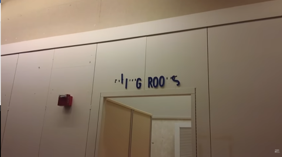
Or a sparse, artificial interior design which recalls The Sims;

Watching the series, one is left with a lingering sense of unease, as if Bell is continuously providing us with a glimpse of the uncanny. To witness something which is contingent on human activity be almost completely emptied of human activity is a remarkably effective aesthetic mode. Indeed, emptiness in general is something of an Internet obsession; one needs only look at ‘The Backrooms’ meme, which mines a kernel of genuine unease out of a faintly recognisable generic ‘non-space’, and the intimation of a Lovecraftian sense of the infinite (for my money, the Backrooms remind me of two toilets in a cinema I used to work at, which often seemed to creak and swell and breath with a life of their own).
Bell’s videos recall Grafton Tanner’s assertion that we ‘risk facing the uncanny in its destabilizing guise’ if we ‘disassemble the tool’ of the ‘interior workings’ of technology. In fact, Tanner’s book ‘Babbling Corpse’, the first notable academic work about vaporwave, shines something of a light on Bell’s methods (which are heavily influenced by vaporwave).
If, as Tanner describes, some of the hallmarks of vaporwave are ‘glitches via repetition or audio effects such as distortion, pitch shifting, and high doses of compression’, then Bell is working well within these parameters. Alongside the eerie, gently swaying shots of the abandoned malls, Bell usually starts, and occasionally punctuates, his videos with repurposed pre-digital VHS footage of public access information videos, corny news reports, and cheesy infomercials. Bell also utilises other left-field aesthetic techniques such as slow zooms into arbitrary elements of the frame (such as a human face), which are popular amongst internet-adjacent comedians like Tim and Eric, and Eric Andre.
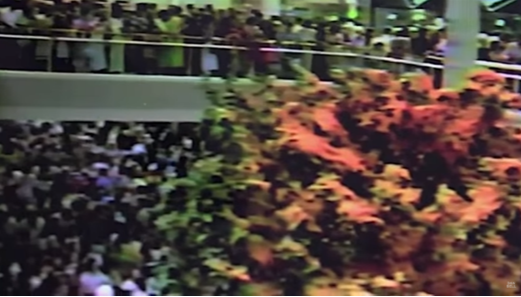
And this is before we get to the phenomenon of ‘mallsoft’ music. Described as ‘a micro-genre of music buried inside another micro-genre of music’, it is a particular form of, or offshoot from, vaporwave which works within a fetishized arrangement of various acoustic accoutrements of ‘mall culture’, centring around a clear loci of nostalgia where traditional vaporwave is content with more generalised visual and aural cues. Although Tanner does not mention mallsoft by name, he does mention malls, as well as write about vaporwave’s presentation of ‘peripheral music’, in relation to vaporwave’s fixation with ‘music of “non-times” and “non-places” because it is skeptical of what consumer culture has done to time and space’.
In terms of the music itself, mallsoft is slowed down samples of generic, off-brand cheesy 80s pop, ultimately much more familiar as a series of musical signifiers (crisp saxophone solos, twinkling piano, repeated vocal phrases) than as music that has come from a movement, with key players and influences. In the same way that filmmakers like Godard and Listorti are creating ‘post-cinema’ from already available cinematic materials, vaporwave is post-music; the originality of the composition comes from the treatment of the pre-existing materials, as opposed to anything newly created. This speaks towards our obsession with the recurrence of ghosts as mediated through errors within common technology; as Tanner writes, ‘we are immediately struck by the characteristics of their ghostliness because their malfunction, actual or perceived, indicates a rift between them and their carried messages’.

The breakdown of the relationship between intent and effect within technology indicates something otherworldly, something that does not belong. This can be categorised as eerie; as Mark Fisher puts it, ‘the eerie is constituted by a failure of absence or by a failure of presence’. Something which should not be there, or something missing, is a hallmark of the eerie. Thus, vaporwave (and the malls) contain within them the kernel of the eerie, because they extrapolate the trappings of various analogue cultures and place them in the present (in a hybridised form, in vaporwaves case). They don’t belong in the present, and they should have ceased to be. Indeed, vaporwave and the mall’s impact is largely contingent on an awareness of their outdated and anachronistic nature; to put it another way, the only true appreciation of vaporwave/malls must be derived from an awareness of how its constitutive elements are no longer ‘enjoyable’ (relevant).
(As an aside, from a political angle, vaporwave/mallsoft perhaps works as the perfectly orchestrated model of ‘working from within’, or the often maligned ‘reformist’ political structures. Mallsoft makes an explicit critique of hypercapitalist incipiencies by climbing inside and wearing it like a grotesque, ill-fitting skin (or a body without organs). This is arguably a post-Situationist arrangement, whereby the critique cannot be subsumed by the organising system, because the lines between the ‘system’ and the critique are blurred (mallsoft critiques as well as simply being an example of an exacerbated version of the thing it is critiquing), and yet the full enjoyment of the vaporwave/mallsoft aesthetic only comes with accepting and understanding its anticapitalist credentials. The only downside to this is that a heavily diluted version of the vaporwave aesthetic has become popular, so.)
In short, vaporwave only exists by being here when it shouldn’t be. It is an exhumed corpse that has had sunglasses placed on its shrunken head, being wheeled around, fooling nobody. And in the same way that vaporwave ‘exhumes corpses’, Dan Bell does the same with the malls that he films; the act of filming them is the act of exhumation, cinema as graverobber, camera as embalmer, retro-future-fitted Gothicism for a generation raised on ghosts in the machine.
The malls, as Bell films them, with his gently swaying shots and occasion glimpses of mirrored figures, feel ‘evacuated’. The malls are sites of activity drained of their purpose, which makes them feel dystopian (as we will see below, this dystopian feeling is more visible in some videos than others). It is this quasi-dystopic angle at which the critique, or comment, on capitalism can enter.
Capitalism thrives inherently on activity; in many ways, it is the ideology of expansion. For capitalism to succeed, it needs to expand beyond its conditions, to reproduce, to grow. It resembles a virus. And yet, there is also the sense in which capitalism is vampiric. It is never self-contained, and it acts upon the world, shaping it to its will. Areas of economic growth move where capitalism makes them; we go to where capitalism tells us to go. This makes the abandoned malls uniquely fascinating; they are an area delineated by capitalist logic, which have served their purpose and yet remained intact.
Mark Fisher wrote about the ‘fungibility’ of capitalism, and the way it sustains itself by being constant adaptable, moldable, pliable. To succeed or accept a capitalist society, you have to be willing to take on different personas at will. It is at its most successful when interrogating the individual at the level of personal identity. We become agents of capitalism by being pliable with our senses of self, and moving through various zones of activity in which we have to ‘play a role’, be it as middle-manager, corporate go-getter, or career-oriented motivator.
Thus, despite the malls operating strictly within capitalism’s logic, by being hubs of commerce with theoretically everything a human being would need to survive, they also seem to flout that logic. Once capitalism is done with a thing, it rarely has a use for it (one needs only to look at Thatcher’s dismissal of various working-class industries to see how this mechanism operates), but most often this ‘getting rid’ is supplanted by the capitalist ethos of expansion and growth. The old thing makes way for the new.
The malls are an outlier in this sense. Whilst they have been replaced by online commerce, nothing has come to fill the geographic sites themselves. The empty shops have not been filled, and the spaces are often stripped of their innards yet left intact as abandoned structures. They are, in a sense, far too brazen, not that capitalism needs to worry about being brazen, too obviously a clue to capitalism’s underbelly of decay.
Further, the malls are so obviously spaces devoid of individuality, non-spaces of incipient functionality, a punctured illusion, when capitalism usually operates best with the wool pulled nice and tight over our eyes. This is likely down to the fact that the malls violate capitalism’s rules of flexibility. While they allow for the individual spaces/units to be gutted and filled with different shops if one shop disappears, the mall site stays put. Capitalism grew more flexible, and the malls outlived their usefulness. #
This ‘tossing aside’ of the malls is displayed effectively in one shot I noticed of a wall with stickers on. The stickers show which shops are in which unit of the mall; some of the stickers have been removed, and because there are no businesses to replace the old ones, the outline of the stickers has remained visible, presumably some years after the spaces were filled with business. With nothing to fill the gap, only the memory of previous commerce can remain, taking up the same amount of space, but weighing significantly less.
Indeed, the fact of their functionality means that there is a particular dissonance when they are viewed in a strictly aesthetic light. Yet, this is where Bell often finds his most disorienting effects, as he is often quick to pass judgement on how a mall looks, feels, how it is optimised for the public, and how it falls short. It does not feel right to think of a mall in these terms, and when Bell describes images such as the below as pretty, or beautiful, it feels wrong, or incorrect. To make qualitative judgements about a mall recalls the metaphor of ‘dancing about architecture’ (although I do not mean this to question Bell’s very sincere commitment to the mall).
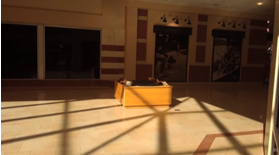
Beyond the handy visual metaphors, however, a large part of the impact of Bell’s videos comes through the sub-visual; a tone, or mood, of absent-presence. To put it in vaporwave terms, they’ve got serious vibes. Despite being liminal spaces with limited applicability to human nature, they do facilitate numerous modes of human behaviour (such as the completion of the commercial urge, consumption of food, and most importantly, a place to ‘hang out’ with friends with no clear purpose). This means that there are rules to a mall. A mall’s functions can only be performed when humans are themselves active. This is why they open during the day, why they are often fitted with skylights to allow light to enter, and why they provide for so many basic areas of human need. They are centres dependent on human activity.
When Bell exhumes them, as he does, he is destabilizing their inherent logic (which is disorienting and uncanny). Never is this more apparent than in the videos where Bell visits a particularly old dead mall, or, more frequently, when he visits a dead mall at night. In his K-MART video, for example, one can see the ‘body’ of the mall grow ill, and slowly succumb to its ailment. The shelves grow more bare, the products on sale less essential/more extraneous, and even the food in the freezer seems to somehow degrade.
The video reaches a climax of sorts when Bell returns after the mall has been completely closed, and stripped of its innards. The once rigidly demarcated spaces between aisles are no more, rendering the space bare and naked. As Bell walks around (triggering an alarm, entering previously closed-off areas, inspecting the toilet), the tone is almost unspeakably creepy. Stripped of light, activity, and purpose, the space seems to become one on which we can transplant the shadowy workings of our unconscious (social and otherwise). .
Or perhaps it is the other way round, and the space is repeating our fears back at us, the fears which have been dictated by media, which were modelled on our fears, and so on. Seeing Bell wander navigate the desolation of the abandoned K-Mart, for example, one is reminded of the uncanny tone of the Shining;
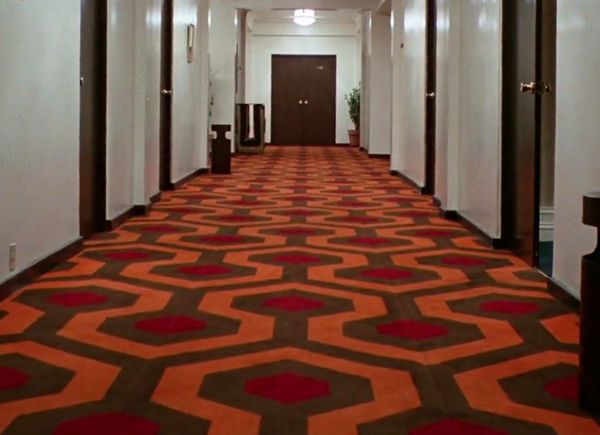
Or perhaps it is easier to recall the stillness and empty space at the heart in Rosemary’s Baby;
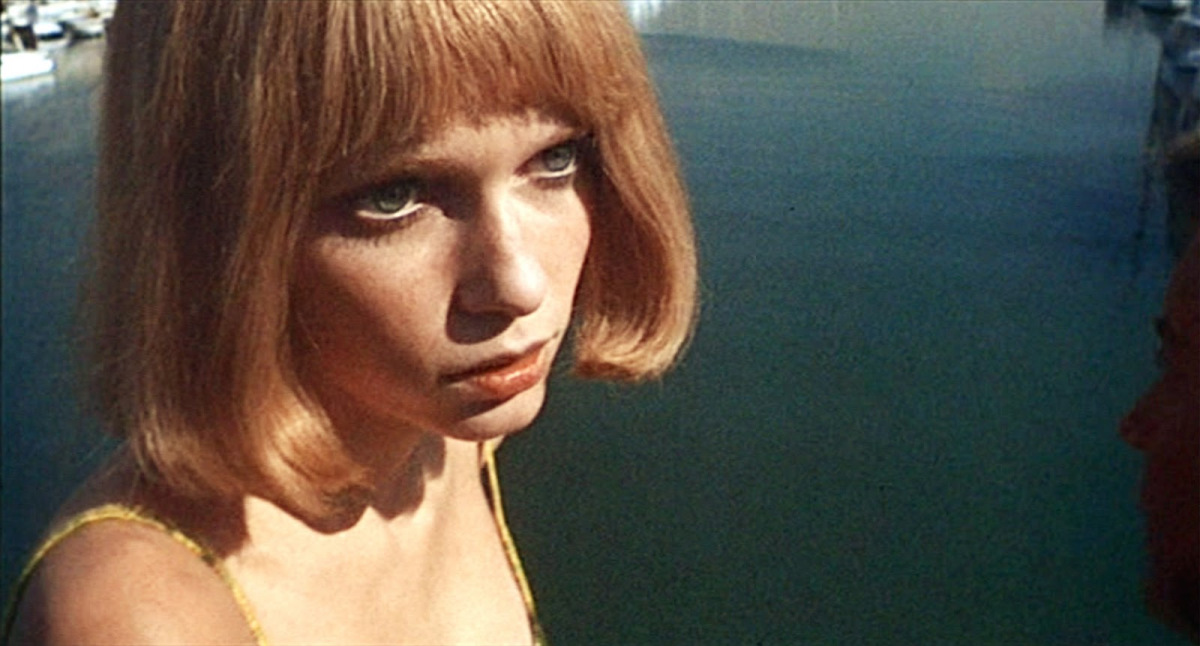
Maybe it is reminiscent of the abnormal noises which punctuate the dreams in Nightmare on Elm Street;
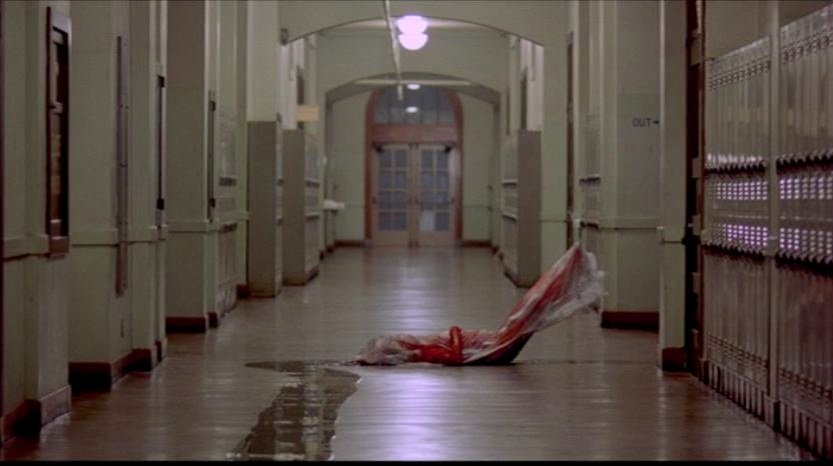
Whatever the case, it does not seem fair to say that we bring our fears to Bell’s videos, or even that Bell’s videos articulate those fears. The reality is likely to be somewhere in the middle, an uncertain reciprocity between what we can read into the videos, and what the videos can read into us, giving with one hand and taking with the other.
Sometimes, although not often, this frisson of dangerousness can transcend the psychological, and become actual. In the Rolling Acres Mall, for example, Bell examines a place which has fallen so far into ruin that it has become genuinely unsafe, a place where rubble drops from the ceiling, where bullet-holes litter the walls, where guards have been removed leaving potentially lethal drops into pits that seem to be reclaimed by nature.
Indeed, Bell talks about the sound of frogs below the mall, a sound which dissipates when someone walks near. This is the closest Bell gets to a literal representation of a post-human dystopia, in which man has been gone for so long that nature has overwritten it. And, almost poetically, the video ends with a group of police officers finding Bell and escorting him out the building. There is a shot as they lead him out, in which their boots loudly crunch glass and detritus, that is so perfect it feels almost staged. It consolidates so many fears, in the failure of commerce, a police state, empty space, controlled behaviour, that it leaves the viewer (and Bell) unnerved, uncertain.

It is, of course, hard not to escape the shackles of hauntology in Bell’s videos. As proposed by Derrida, hauntology can broadly be defined as an obsession with ‘lost futures’, a regressive, fixative urge to ‘return’ to a moment which never happened. Tanner writes that ‘hauntology posits that the past notions of the future have in some way failed, causing a disruption of time as an orderly sequence of past, present, and future.’ This is certainly the case for vaporwave, which revives old trends, layers them with the contexts of our time, and makes something new out of them; and yet, despite the sinuous link between vaporwave and Bell’s videos, the direct application of hauntology to the malls is much more slippery than it might seem.
One angle of approach would be to posit the malls as hauntological sites by virtue of their failures. Yet hauntology is typically concerned with the past bearing on the present; whilst Bell’s videos consider the malls in present contexts, they almost invert the hauntological urge. It is as if they deliver a missive from an unknown future, in which the sites of capitalism are decomposing and broken.
It is not hard to see that the malls drip with decay. Whilst it could be argued that this decay, this rot, has always been present, and it is only with the corroding force of time that we have been allowed to see them, they are too pointed as failures of capitalism to truly be considered a future which has not come to pass; they are a future which is likely to come to pass in the next few years. This is perhaps the clearest distinction between the malls and the vaporwave aesthetic. Where vaporwave derives its power from asserting an almost accelerationist future, in which the processes and false edges of capitalism have crystallised into their own weird simulacra, the malls simply… Exist. There is only so far theory can take you; I believe it is to here.
If the malls are indeed sites of failed futures, then Bell’s videos act as funerals for those futures.
His tone is certainly mournful. Though he approaches the malls fairly neutrally, and in his first-person viewpoint allows us to experience them without being guided, there is a pervasive sense of sadness. In the Rolling Acres Mall, for example, he talks over lingering shots of a geometric metal ceiling-piece about how nobody is around to appreciate them any more, and how that’s a shame. When he does talk about the malls, it is as if he is a parent, with a very keen sense of both their successes and failures. What can’t be denied is his genuine appreciation for their beauty, their architecture, and design.
I wrote above about the dissonance between viewing the malls aesthetically and considering their actual function. Bell is no doubt aware of this, and this peculiar kernel of novelty is likely a direct factor in his channels’ continued success. And yet, I feel it would be disingenuous not to make the observation that the videos also derive their effects from the way in which Bell has so obsessively nominated himself the visual archivist for his subject(s). Further, if we accept the idea that we only archive that which is no longer present, or current, Bell is also the mall’s guide into the afterlife. This is something he does carefully, and almost certainly out of love.
You will always find beauty in that which you love.
Back And Forth (1969), dir. Michael Snow
Michael Snow’s 1968 film ‘Back and Forth’ makes a chiral out of limitation and potential, proving with deftness and rigour that the two seemingly disparate concepts can work as one and the same when the conditions are right. The form of his film is simple; a camera moves, fixed, back and forth, panning a run-down and dimly-lit classroom. When it hits the edge of what is presumably a block, there is a tap, or knock, and then the camera moves the other way. This is the film, over and over again, in various permutations for 50 minutes.
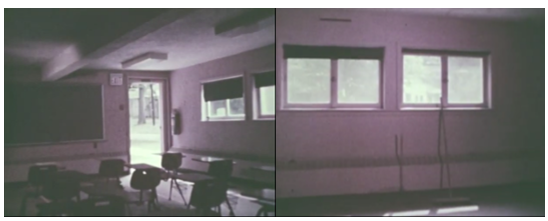
The speed at which the camera moves varies, sometimes moving so fast that it becomes a blur, sometimes so slowly that it is minimal. There are large swathes of the film where nothing is happening, other than this movement (and even when something is happening, it is not in clearly defined narrative terms- more like arrangements within the frame, such as a large gathering of people, or someone in the doorway, or window).
It is a highly conceptual piece, and indeed Snowworks under the umbrella of ‘Structural Cinema’. This was a name coined by P. Adams Sitney, in relation to a loosely connected group of avant-garde film artists who worked within a post-Brechtian reduction of the moving image to its most composite elements, in an attempt to force the viewer to question their most basic notions of cinematic perception.
As Snow sketches his film, it operates like the inverse of Brakhage’s process; if Brakhage (who was not part of Structural Cinema) sought to dismantle the logic of human vision by rendering cinematic images from the outside as disparate, abstract compositions, constantly shifting and evolving, then Snow works within restricted forms of those images to indicate their haptic potential if handled in the correct manner. Snow’s method also resembles a filmic equivalent of Boulez’s ‘Structures’, which used integral serialism to explore possibilities for new sounds distinct from more traditional compositional technique.
(indeed, if Brakhage and Snow are aesthetic opposites, then Snow attempts, roughly, a Brakhagian image in the ‘climax’ of this film, and it’s notable how much remains legible even as the image falls apart in front of us)
As the camera continues to move back and forth, back and forth, the viewer cannot help but be drawn in. My assumption that there were two main fields of vision gave way to the realisation that there are four- the camera view from the left, and the camera view from the right, but then the view from right-to-left, and left-to-right, each having distinct visual perspectives and capturing particular specifities of motion. Indeed, it seems to recall Boulez’s wish to find ‘a perfectly new synthesis’, one ‘not corrupted from the very outset by foreign bodies’.

The way the camera pans (as opposed to tracking, or dollying) indicates a swinging motion not dissimilar to digging, and the repetitious rhythm feels a little bit like something is being carved, a new visual revelation with each movement. One morbid reading could be of the camera and cinematography as a pendulum, swinging closer and closer to a destination that is perhaps out of reach.
Any morbidity could be corroborated by the fact that the film does, in some way, function as a horror film; it certainly articulates in a primitive form a number of techniques which would go on to become horror shorthand in the genre’s 70s heyday. The constantly shifting frame from such a rigid and fixed position ‘traps’ the viewer, as if you can look left and right but not move your head. Whilst this sensation does abate, there are moments when a figure will suddenly appear in the hallway, or window, and disrupt the field of vision in an upsetting way.
Whilst these figures are not in themselves scary (as horror-proper images they would be crude and unsophisticated), the horror comes in the discrepancy between how Snow attunes the viewer so acutely to the frames’ tightly controlled minutiae, and the seemingly random way in which he inserts various elements. This, coupled with the sense of being ‘trapped’ is perhaps a distillation of the horror mechanism to its most basic form.
When it is not scary, it is fascinating. In one spellbinding instance, a woman walks slowly across the room while the camera pans seems to divide the woman into different, liminal, captured spaces; first she is on the right of the room, then the camera moves left, then back to right, and she is gone; the camera moves left again, and she is there; the camera moves right, and then left, and she has left through the door. In its way, this sequence tells you all you could ever wish to know about how the movie camera delineates space through visual editing, assigning value to arbitrary potions contained within its field of view (within an unbroken shot, no less) that are tactile, interactive.
Whilst the work sounds repetitious, as if it has repetition baked into its DNA, Snow seems to undermine the concept of repetition within this work. If repetition, as typically defined, is seeing the same thing over and over again, then Snow does not fit that definition. It initially seems to operate as a cinematic epanalepsis, repeating the ‘clauses’ within Snow’s one cinematic sentence by returning to them with each swing of the pendulum-camera.
Snow injects too much variation, via speed and mis-en-scene for us to consider the image as being truly replicated. As the work continues, Snow’s images and allusions take on the quality of layers of butter pressed between pastry being folded and rolled, one layer becoming two, and then four, and so on.
Erin Manning has written in her work ‘Relationscapes’ that ‘stability is vision’s illusion’. What we take to be stillness is actually ‘an appearance of the composed relation across moments’. There is no such thing as stillness, only an illusion which we take for granted. In this same manner, Snow creates a ‘composed relation’ which, whilst having the form of one thing (a fixed series of shots), slowly reveals itself as multitudinous and aesthetically dense. In probing so deeply into his own, self-composed ‘vision’s illusion’, Snow’s effect calls into question the very nature of cinema, of images, of watching. It is a deeply vital work that anyone even halfway interested in cinema-as-art should immerse themselves in.
To have created so much from so little is a form of wizardry.
Symbiosmosis; or, the Real Inescapability of COVID-19
Walking through Brighton today, along the main road adjacent to Old Steine, a bus passed by which had the words ‘HIV Isn’t Scary Anymore’ printed in big white letters atop a flowery purple background. While this kind of thing is par for the course for Brighton, a town which wears its LGBT bona-fides with upfront visibility, such a frank statement was startling, containing the not-so implicit declaration that HIV was scary. The admittance of this was unusually candid; HIV was scary, but largely for reasons engendered and worsened by the same kind of people who usually pay to have their messages on the sides of buses. But mainly, seeing the message also seemed grimly ironic, grimly apropos, given everything that is currently happening in the world. Continue reading “Symbiosmosis; or, the Real Inescapability of COVID-19”
